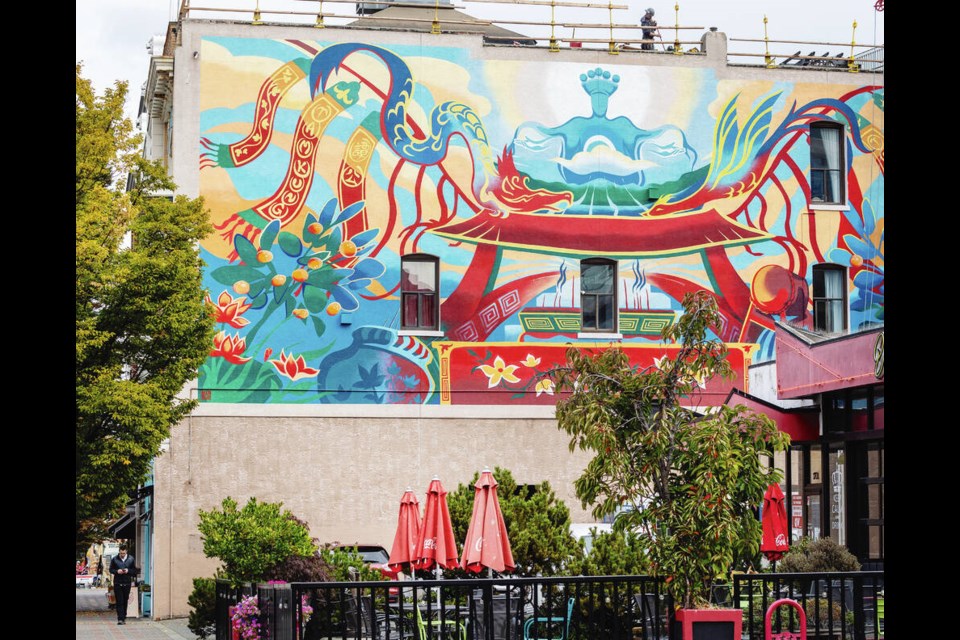The new 32-foot tall mural on Government Street depicting objects from Victoria Chinatown’s Tam Kung Temple was finished just before the rain began to fall. “If we had taken even a day off, I think we may not have beat the weather,” said muralist Carolyn Wong.
The spray-painted mural on the side of the building that houses Tam Kung Temple, Canada’s oldest Chinese temple, was commissioned by the City of Victoria.
It covers 2,179 square feet on the south wall of 1713 Government St. at the Chinatown intersection where the Gate of Harmonious Interest stands.
After three days of preparation, painting started on Sept. 14 and finished on Sept. 22, three days ahead of schedule.
Temple artifacts, such as the floral embroideries and sponsorship banners damaged or burnt in a 1980 building fire, are freshly reimagined in Wong’s work.
The Vancouver-based artist said the design came easily to her after she was awarded the mural contract. “I had been thinking about it for months.”
The initial design was sketched out on an iPad app. But to translate a digital file into a roughly 32-by-69-foot spray-painted street mural would require more than just copy and paste.
The first three days of the job were spent removing existing artwork, prying out rusty screws, and patching holes in the wall.
Her assistant, Braden Stein, helped to power wash the surface and gave the stucco wall a new coat of white paint.
“If you don’t prime the wall, the colours will look more dull. So the base coat is really important,” she said.
The subsequent days were spent putting on the colours.
Every day, Wong and Stein would arrive at the base of the wall, squeeze onto a boom lift with an improvised paint shelf, and start working on the mural.
“It’s a lot of mental and physical energy because you’re trying to not think about the fact that you’re like 50, 60, feet up in the air,” she said.
There’s also the pressure of having to recreate the draft artwork accurately without being able to step back and see the whole piece.
To help with that, blue doodles were sprayed across the wall first to act as a reference point, Wong said.
“I put the artwork digitally on top of it, so that it creates a mapping system.”
That way, Wong was able to recognize what to paint by the specific doodle mark in front of her. “We’re human printers, in a sense.” The two slowly spray-painted their way from top to bottom, left to right.
It took about 170 cans of spray paint to complete the mural, 20 more cans than anticipated. “Thankfully, Opus [Art Supplies] was just down the street.”
Spending most of their days on top of a swaying boom lift meant that the two muralists got a curious case of the sea-legs. “You’re just like floating all the time,” Wong said.
The two were loath to leave the boom lift, limiting themselves to a single lunch break in their 9-hour days.
“With every lift movement, it just takes additional time and energy,” she said. “We were trying to work as efficiently as possible.”
It turned out to be to their advantage. Only the mural’s weather-resistant protective coating would be delayed by the rain that fell shortly after the spray painting was finished. “With a UV coating, it protects the colours from fading for a very long time,” Wong said, adding that to protect the mural, she’ll use the same stuff used in sealing roads.
Richard Leong, a professor of visual arts at the University of Victoria, said he was impressed by how quickly the mural was completed. “Two weeks? That blows me away.”
Victoria’s Chinatown was once much more expansive than what it is now, he said. “It’s great to make culture outwardly visible in that way, there’s such a rich history of Chinese diaspora.”
The cloud and thunder iconography that can be found throughout Wong’s mural has roots so ancient that it likely originated with the birth of agriculture in China, he said.
He’s also a big fan of the use of spray paint, calling it both practical and a reflection of the hybridization of Chinese culture outside of China.
“Being able to co-opt that language and use it to turn people’s gaze … that’s really interesting to me.”
Total budget for the project is $44,400. It was funded through the city’s OUR DWNTN revitalization fund with contributions from the Downtown Victoria Business Association and Sunbelt Rentals.
>>> To comment on this article, write a letter to the editor: [email protected]



